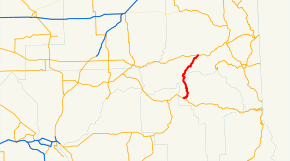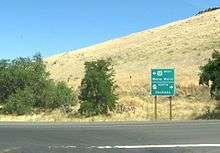Washington State Route 127
State Route 127 (SR 127) is a 27.05-mile-long (43.53 km) state highway serving the eastern region of the U.S. state of Washington. The highway, listed on the National Highway System, begins in rural Garfield County at U.S. Route 12 (US 12) and travels north across the Snake River on the Elmer Huntley Bridge. The roadway continues into Whitman County before it ends at SR 26 in Dusty. SR 127 formed a section of the Inland Empire Highway and Primary State Highway 3 (PSH 3) prior to becoming US 295 in 1926. US 295 was decommissioned in 1968 and replaced by a longer SR 127, traveling its full length from Dodge to Colfax from its establishment in 1970 until an extension of SR 26 to Colfax in 1979.
| ||||
|---|---|---|---|---|
 SR 127 is highlighted in red. | ||||
| Route information | ||||
| Auxiliary route of US 12 | ||||
| Defined by RCW 47.17.250 | ||||
| Maintained by WSDOT | ||||
| Length | 27.05 mi[1] (43.53 km) | |||
| Existed | 1970[2]–present | |||
| Major junctions | ||||
| South end | ||||
| North end | ||||
| Location | ||||
| Counties | Garfield, Whitman | |||
| Highway system | ||||
| ||||
Route description

SR 127 begins at an intersection with US 12 in the unincorporated community of Dodge, located between Starbuck and Pomeroy in rural Garfield County.[3] The highway travels north around Dodge Hill and into the hills along New York Gulch before reaching the Snake River.[4][5] SR 127 crosses the Snake River on the Elmer Huntley Bridge into Whitman County east of the former Central Ferry State Park.[6] The highway continues northeast up the Central Ferry grade to Dusty,[7] where SR 127 ends at an intersection with SR 26.[8]
Every year, the Washington State Department of Transportation (WSDOT) conducts a series of surveys on its highways in the state to measure traffic volume. This is expressed in terms of average annual daily traffic (AADT), which is a measure of traffic volume for any average day of the year. In 2012, WSDOT calculated that the busiest section of SR 127 was its northern terminus at SR 26, serving 1,000 vehicles.[9] The entire route of SR 127 is designated as part of the National Highway System,[10] a highway system that includes roadways important to the national economy, defense, and mobility;[11] and as a Highway of Statewide Significance by WSDOT,[12] which includes highways that connect major communities in the state of Washington.[13]
History
| |
|---|---|
| Location | Dodge – Colfax |
| Existed | 1926–1968 |
The present route of SR 127 was added to the Washington state highway system in 1913 as part of the Inland Empire Highway,[14] traveling in a circular arc from Ellensburg through the Yakima Valley and into the Palouse towards the Canadian border in Laurier.[15] The Inland Empire Highway was numbered as State Road 3 in 1923 and PSH 3 in 1937 as part of the primary and secondary state highways.[16][17] The United States Highway System was adopted on November 11, 1926 by the American Association of State Highway Officials (AASHO) and included US 295,[18] traveling northeast from US 410 at Dodge to US 195 in Colfax and crossing the Snake River at Central Ferry.[19] US 295 succeeded PSH 3 during the 1964 state highway renumbering,[20] but was decommissioned in 1968 before the new state highway system was codified.[21][22] The roadway was re-designated as SR 127 after the new sign route number system was codified into the Revised Code of Washington in 1970,[2] traveling 43.82 miles (70.52 km) from US 12 at Dodge to US 195 in Colfax and crossing the Snake River on the Elmer Huntley Bridge, completed in 1969.[23][24] SR 127 was truncated to its present route after SR 26 was extended east to Colfax over the former route of SR 127.[2][25]
Major intersections
| County | Location | mi[1] | km | Destinations | Notes |
|---|---|---|---|---|---|
| Garfield | | 0.00 | 0.00 | Southern terminus | |
| Snake River | 9.65– 10.00 | 15.53– 16.09 | Elmer Huntley Bridge | ||
| Whitman | Dusty | 27.05 | 43.53 | Northern terminus | |
| 1.000 mi = 1.609 km; 1.000 km = 0.621 mi | |||||
References
- Staff (2012). "State Highway Log: Planning Report 2012, SR 2 to SR 971" (PDF). Washington State Department of Transportation. pp. 1057–1061. Retrieved March 20, 2013.
- "47.17.250: State route No. 127". Revised Code of Washington. Washington State Legislature. 1979 [1970]. Retrieved March 20, 2013.
- "Feature Detail Report for: Dodge". Geographic Names Information System. United States Geological Survey. September 10, 1979. Retrieved March 20, 2013.
- "Feature Detail Report for: Dodge Hill". Geographic Names Information System. United States Geological Survey. September 10, 1979. Retrieved March 20, 2013.
- "Feature Detail Report for: New York Gulch". Geographic Names Information System. United States Geological Survey. September 10, 1979. Retrieved March 20, 2013.
- "Feature Detail Report for: Central Ferry State Park". Geographic Names Information System. United States Geological Survey. May 1, 1991. Retrieved March 20, 2013.
- "Feature Detail Report for: Dusty". Geographic Names Information System. United States Geological Survey. September 10, 1979. Retrieved March 20, 2013.
- Google (November 25, 2010). "State Route 127" (Map). Google Maps. Google. Retrieved November 25, 2010.
- Staff (2012), 2012 Annual Traffic Report (PDF), Washington State Department of Transportation, p. 141, retrieved March 23, 2013
- National Highway System: Washington (PDF) (Map). Federal Highway Administration. October 1, 2012. Retrieved March 20, 2013.
- What is the National Highway System?, Federal Highway Administration, September 26, 2012, retrieved March 20, 2013
- Transportation Commission List of Highways of Statewide Significance (PDF), Washington State Transportation Commission, July 26, 2009, retrieved March 20, 2013
- Lorenzo, Judy, Highways of Statewide Significance, Washington State Department of Transportation, retrieved March 20, 2013
- Washington State Legislature (March 12, 1913). "Chapter 65: Classifying Public Highways". Session Laws of the State of Washington. Session Laws of the State of Washington (1913 ed.). Olympia, Washington: Washington State Legislature. p. 221. Retrieved March 21, 2013.
A highway connecting with the Sunset Highway at or in the vicinity of the city of Ellensburg; thence by way of North Yakima, Kennewick, Pasco, Walla Walla, Dayton, crossing the Snake River at either Almota or Penawawa, Colfax, Rosalia, Spokane, Deer Park, Loon Lake, Colville, to the international line at boundary, which shall be known as the Inland Empire Highway.
- State of Washington Showing State Highways Authorized by Legislative Acts of 1915 (DJVU) (Map). Washington State Bureau of Statistics and Immigration. 1915. Retrieved March 21, 2013.
- Washington State Legislature (March 19, 1923). "Chapter 185: Primary and Secondary State Highways". Session Laws of the State of Washington. Session Laws of the State of Washington (1923 ed.). Olympia, Washington: Washington State Legislature. p. 627. Retrieved March 21, 2013.
A primary state highway, to be known as State Road No. 3, or the Inland Empire Highway, is established as follows: Beginning at the international boundary line at Laurier in Ferry County; thence by the most feasible route in a southerly direction through Colville, Spokane, Colfax, Dayton to Walla Walla; thence in a northwesterly direction through the cities of Wallula, Pasco, Sunnyside, Yakima, Ellensburg, to a junction with the Sunset Highway at or near Virden in Kittitas County.
- Washington State Legislature (March 17, 1937). "Chapter 190: Establishment of Primary State Highways". Session Laws of the State of Washington. Session Laws of the State of Washington (1937 ed.). Olympia, Washington: Washington State Legislature. p. 934. Retrieved March 21, 2013.
A primary state highway to be known as Primary State Highway No. 3, or the Inland Empire Highway, is hereby established according to description as follows: Beginning at a junction with Primary State Highway No. 2 in the vicinity east of Cle Elum, thence southeasterly by the most feasible route by way of Ellensburg, Yakima, Pasco and Wallula to Walla Walla, thence in a northerly direction by the most feasible route by way of Dayton, Dodge, Colfax, Rosalia, Spokane and Colville to the international boundary line in the vicinity of Laurier.
- Weingroff, Richard F. (January 9, 2009). "From Names to Numbers: The Origins of the U.S. Numbered Highway System". Highway History. Federal Highway Administration. Retrieved March 18, 2013.
- Bureau of Public Roads & American Association of State Highway Officials (November 11, 1926). United States System of Highways Adopted for Uniform Marking by the American Association of State Highway Officials (Map). 1:7,000,000. Washington, DC: U.S. Geological Survey. OCLC 32889555. Retrieved November 7, 2013 – via University of North Texas Libraries.
- Prahl, C. G. (December 1, 1965). "Identification of State Highways" (PDF). Washington State Highway Commission, Department of Highways. Retrieved March 21, 2013.
- "State Approves Route Extension". Lewiston Morning Tribune. April 21, 1966. p. 12. Retrieved March 22, 2013.
- Northwest, 1967 (Map). Rand McNally. 1967. Retrieved March 22, 2013.
- Staff (1970). "Annual Traffic Report, 1970" (PDF). Washington State Highway Commission, Department of Highways. p. 132. Retrieved March 23, 2013.
- "NRHP Washington State Historic Highway Bridges" (PDF). Washington State Department of Transportation. March 21, 2013. p. 2. Retrieved March 23, 2013.
- Staff (1980). "Annual Traffic Report, 1980" (PDF). Washington State Department of Transportation. p. 130. Retrieved March 23, 2013.
